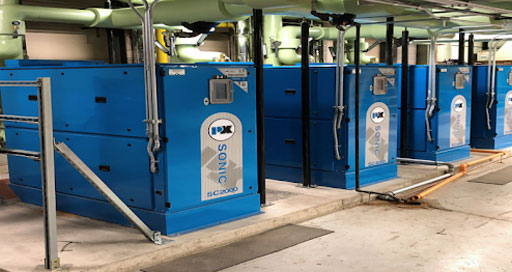Condensing boilers achieve high efficiency by condensing water vapor in the exhaust gases to recover latent heat, which would otherwise be wasted. A conventional boiler burns fuel, producing hot gases that pass through a heat exchanger where much of the heat is transferred to the water. Vapor produced in the combustion process rises into the stack. A condensing boiler captures additional heat from this vapor by condensing it to a liquid to provide a significant increase in operational efficiency.

Condensing boilers produce a condensate that is somewhat acidic, so appropriate materials must be used for the heat exchanger. Corrosion, most commonly pitting, can lead to catastrophic problems if the proper alloy is not selected.
Pitting occurs when chloride molecules in the condensed flue gas dissolve the chromium oxide on the passive layer surface of the heat exchanger, leaving iron that is susceptible to corrosion. Chlorides combine with the iron to form ferric chloride, resulting in spherical pits that bore into the metal surface. Materials are rated according to their Pitting Resistance Equivalent Number (PREN). The greater the PREN, the more resistant to pitting the material.
Aluminium alloys and stainless steel are most commonly used at high temperatures. In the case of stainless steel heat exchangers, 316L stainless steel is widely used. 439 stainless steel is a newer option with its own merits and drawbacks.
316L Stainless Steel
The microstructure of 316L classifies it as an austenitic stainless steel. A distinguishing characteristic of 316L is the presence of nickel and molybdenum. For the most part, 316L is unaffected by residual amounts of chlorides found in flue gas condensate.
Workability Characteristics
- Highly formable with an elongation break at 60%
- The thermal stress is easily managed for better ductility and drawing
- Low carbon content prevents carbide precipitation during welding, improves corrosion resistance
- Presence of Ni and Mo makes it easier to weld and maintain
Performance
Corrosion Resistance
Nickel is added (in percentages above 8%) to increase an alloy’s resistance to oxidation, nitriding, thermal fatigue and strong acids. While the addition of nickel imparts considerable durability and strength as well as resistance to oxidation and corrosion, it also increases costs.
Pitting Resistance
316L stainless steel has a PREN of 22.6. A molybdenum content of 2% is added to 316L to improve resistance to pitting corrosion, particularly by chlorides and sulfur chemicals. Mo significantly reduces the tendency of steels to decay during heat treatment and while in use. Natural gas flue condensate does not contain high enough concentrations of chlorides or low enough pH levels to cause a pitting issue for 316L.
Crevice Corrosion
The higher the percentage of molybdenum in a material, the higher the PREN. Crevice corrosion is prevented by the presence of Mo.
Stress Corrosion Cracking
Austenitic stainless steel may be subject to stress corrosion cracking in the presence of chlorides when under tensile stress. 316L performs equally as well as 439 in stress corrosion tests since it has a high nickel content and the addition of molybdenum.
439 Stainless Steel
The microstructure of 439 makes it a Ferritic stainless steel. Though stainless steel is widely considered to be non-magnetic, ferritic stainless steels do possess magnetic qualities. 439 stainless steel does not contain nickel, making it a lower cost alternative to 316L. The use of 439 in a condensing boiler application depends on acid pH levels in the flue gas condensate.
Workability Characteristics
- Very brittle with an elongation break at 22%
- 316L can be used as a filler material
- Ti and Nb can be added to stabilize the HAZ zone to prevent precipitation of carbides
- Highly skilled welders are required
Performance
Corrosion Resistance
While 439 does not contain nickel or molybdenum, it does have trace amounts of titanium to enhance its corrosion resistance.
Pitting Resistance
439 has a PREN of 17. The use of ferritic stainless steel alloys such as 439 in a condensing boiler application relies on acid pH levels always staying above 4 to prevent pitting corrosion.
Crevice Corrosion
Acidic conditions and crevice-ike configurations can lead to pitting in 439 stainless steel.
Stress Corrosion Cracking
Ferritic stainless steels typically perform well in stress corrosion cracking tests, however they have a poor capacity to repassivate in acidic environments, which can result in problems. The addition of titanium to 439 improves its stress corrosion cracking performance.
It is clear that 316L outperforms 439 in two areas that are critical to performance in condensing boiler heat exchanger applications, pitting and crevice corrosion. Cost is always a factor, but considering the expected long service life of a condensing boiler, the added cost of 316L is marginal for the benefit received and has a direct impact on future maintenance costs.
Lathrop Trotter is highly skilled and experienced in the selection of boiler equipment to suit specific application needs. Contact us today to discuss your project.
Questions? Your Lathrop Trotter sales engineer can help! Contact Us


